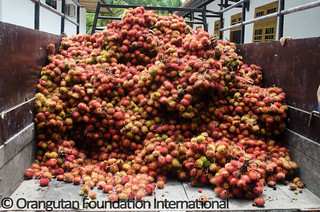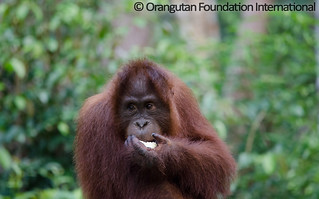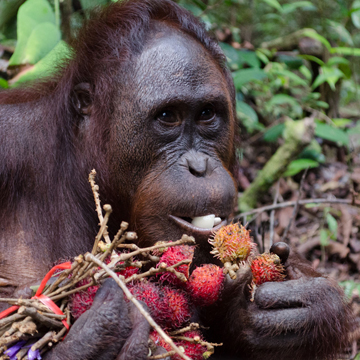Tags:
OCCQ rehabilitationIt is early in the morning at OFI’s OCCQ. The staff is huddled around the kitchen fire, sipping coffee and discussing the plan for the day’s “soft releases” when orangutans are released into the forest for the day before being brought back to their sleeping cages in the late afternoon. The jarring sound of an arriving pick-up truck catches the attention of the OFI enrichment and food preparation team. Without hesitation, the staff quickly heads out the door to greet the expected delivery.
 The truck carefully turns around and it is only when it comes to a complete stop that the hefty cargo it bears is visible. In the bed of the pick-up sits the largest pile of coconuts that you have ever laid eyes on. So many coconuts, in fact, that the sudden stop has thrust some of the coconuts off the side of the truck bed, where they are now rolling down the pavement in all directions.
The truck carefully turns around and it is only when it comes to a complete stop that the hefty cargo it bears is visible. In the bed of the pick-up sits the largest pile of coconuts that you have ever laid eyes on. So many coconuts, in fact, that the sudden stop has thrust some of the coconuts off the side of the truck bed, where they are now rolling down the pavement in all directions.
It’s an arrival that has not gone unnoticed by the Care Center’s orangutans. Smacking lips and slapping hands, their sounds and displays of excitement, can be heard throughout the Care Center’s central facilities as the orangutans eagerly anticipate their first morning feed. This is just one of several food deliveries that will be made this week. At least several trucks will arrive, teetering down the stone driveway, the trucks completely overflowing with fruit. It is quite a sight but you quickly learn that enormous food deliveries are rather commonplace at the OCCQ. After all, how else are you going to feed 330 orangutans?
Since the large island of Borneo is located on the equator, many different types of plants and trees flourish here in the warm climate. These plants and trees bear some of the tastiest fruit in the world. It is no surprise that orangutans and other frugivores call this island home. The variety of fruits that are ripe and available varies between the wet and dry seasons but compared to many other places in the world, Borneo is a fruit-eater’s paradise. Orangutans are considered frugivores, in that ripe fruit, which wild orangutans find in the primary rain forests which used to cover much of Borneo, makes up the largest portion of their diet. The rest of their diet includes young leaves, small insects, flowers, and bark.
In the wild, orangutans spend most of their days foraging for food. Gently put — they aren’t the type to miss a meal. Because of the large number of orangutans currently cared for by OFI, and the frequency with which orangutans like to snack– stocking, ordering and preparing food is one of the most time-consuming activities of OFI staff’s daily operations.
 From the back of trucks and pickups, to boxes, and storage rooms, an enormous food delivery can move its way pretty quickly through the Care Center. It is not unusual for it to disappear in just one feeding session! This is why food deliveries are so critical to running the OCCQ. Dedicated staff in the kitchen may work for hours cleaning, chopping, and preparing food for meal times. Many times, other staff members will chip in to help the process along.
From the back of trucks and pickups, to boxes, and storage rooms, an enormous food delivery can move its way pretty quickly through the Care Center. It is not unusual for it to disappear in just one feeding session! This is why food deliveries are so critical to running the OCCQ. Dedicated staff in the kitchen may work for hours cleaning, chopping, and preparing food for meal times. Many times, other staff members will chip in to help the process along.
In order to mimic the day-long browsing behavior of wild orangutans, the Care Center orphans are fed frequent meals several times over the day. The daily special is whatever is available. Depending on the time of the year, that might mean coconuts and papayas, or it might mean bananas and squash. By and large, there is no mistaking the orangutans’ absolute favorite seasonal fruits: durian, cempadak (a type of jack fruit), mangoes, and rambutan! In the dry season when these treats are ripe for the picking, the orangutans simply cannot get enough of these yummy sweet tropical fruits. Like humans, orangutans will often avoid eating the skin of many types of fruit, instead preferring to pick out the soft and sweet insides. And just like us, they are certainly not beyond playing with their food. In fact, the OFI Enrichment Team counts on this! Food-based enrichment is one of the orangutans’ favorite games.
 While orangutan eating habits might seem indulgent, the constant browsing of orangutans is actually a vital part in the survival of Borneo’s rainforest. Orangutans act as natural seed dispersers for many types of plants, helping expand the areas and density of forests. As they forage and browse for their next meal, they also open up the tree canopy a bit, allowing light to reach the forest floor in a non-destructive way which, in turn, helps the forest regenerate.
While orangutan eating habits might seem indulgent, the constant browsing of orangutans is actually a vital part in the survival of Borneo’s rainforest. Orangutans act as natural seed dispersers for many types of plants, helping expand the areas and density of forests. As they forage and browse for their next meal, they also open up the tree canopy a bit, allowing light to reach the forest floor in a non-destructive way which, in turn, helps the forest regenerate.
Until the OFI orphan orangutans are able to return to the wild and reclaim their rightful place in the forest ecosystem, OFI staff will continue to work hard to the feed hundreds of orphans living at the OCCQ. But they can’t do this without your support.
 When you make a general donation to OFI, know that part of your money is going towards feeding a vast and ever growing population of rehabilitant orangutans, orphan orangutans on their way back to the wild. Sign up as a foster parent https://orangutan.org/product-category/foster-parent-kits/ and be a direct contributor to the care of a young, orphaned orangutan. As they say, the best way to the heart is through the belly.
When you make a general donation to OFI, know that part of your money is going towards feeding a vast and ever growing population of rehabilitant orangutans, orphan orangutans on their way back to the wild. Sign up as a foster parent https://orangutan.org/product-category/foster-parent-kits/ and be a direct contributor to the care of a young, orphaned orangutan. As they say, the best way to the heart is through the belly.



